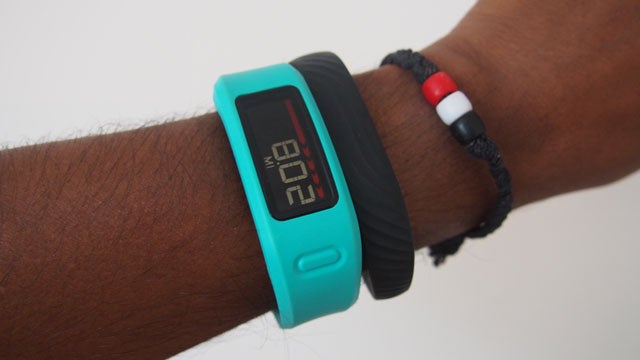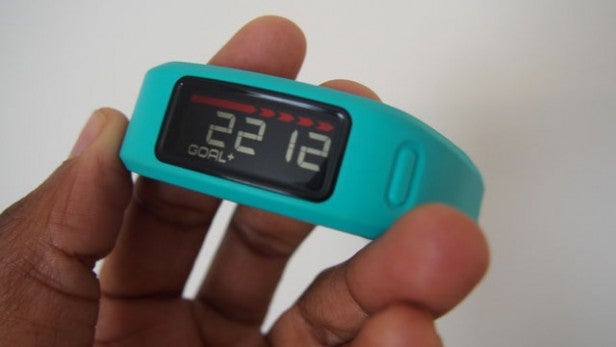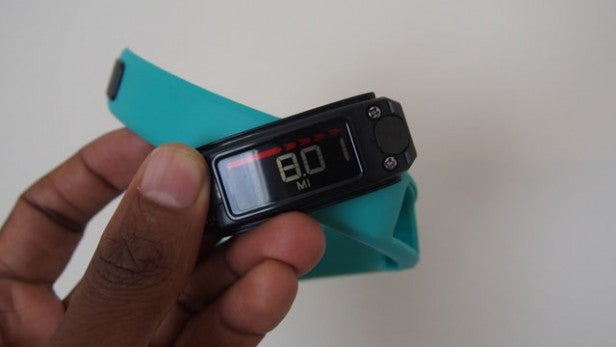Garmin Vivofit Review
Garmin Vivofit
Garmin's first fitness tracker is good but not the best

Sections
- Page 1 Garmin Vivofit Review
- Page 2 App, Performance, Battery Life and Verdict Review
Verdict
Pros
- Water-resistant design
- Personalised step goals keep you motivated
- Year-long battery life
Cons
- No backlight for display
- No Altimeter
- Troublesome syncing and uploading data
Key Specifications
- Review Price: £99.99
- Year long battery life
- LCD screen (with no backlight)
- Accelerometer fitness tracking
- Waterproof to 50m
First reviewed: 6/5/2014
The Garmin Vivofit is now available for £79.99 from a number of retailers, that’s around £10 more than some other trackers that don’t come with screens or year long battery life.
What is the Garmin Vivofit?
The Garmin Vivofit is a fitness tracker that joins the Nike Fuelband SE, the Jawbone UP24, and Samsung Gear Fit – just to name a few – battling for a place around your wrist. The Swiss company is of course no stranger to making data tracking hardware whether it’s the GPS-packing Edge cycling computers or Forerunner running watches. This time Garmin is stripping out the GPS and focusing on counting steps and helping people make more gradual improvements to their day-to-day lives. It’s great value at £99, though there’s some issues that prevent it from being the best fitness tracker out there.
Garmin Vivofit: Design
If you are hoping for a fitness tracker that can live inconspicuously on the arm then the Vivofit doesn’t fit the bill. The rubbery flexible band which holds the tracking module looks pretty cheap and reminds us of the Livestrong wristbands albeit with a wider body. It’s aesthetically got more in common with the Fitbit Flex than something like the Jawbone UP24 or the Fuelband SE and even uses a similar clasp to keep the band secure around the wrist.
It weighs just 25.5g making it about as light as the Jawbone UP24 (23g) and the smallest Nike Fuelband SE (27g). There’s small (120-175mm) and large (152-210mm) band sizes both provided in the box and these can be swapped with different coloured straps which cost an additional £20 each.
One of the biggest advantages over rival trackers is that you don’t have to take it off when you are in the shower or going swimming. It’s water resistant up to 50m and while that means it’s pretty much a band you can wear all the time, there are no dedicated swimming features to truly make the most of it.
READ MORE: Fitness Band Reviews
Then there’s the always-on display. 25.5mm wide by 10 mm high, it’s a simple LCD display, so not the super vibrant AMOLED touchscreen on the Gear Fit, but it’s perfectly suited for quickly glancing down at your stats and means you are not tied entirely to your smartphone to keep a check on progress. That is until it gets dark. Garmin has decided not to include a backlight at all, no doubt to improve battery life, and as a result it’s very difficult to go out for an evening run or even set up sleep tracking without having to reach for the bedside lamp or flash a smartphone screen in its direction.
There’s just a single button beside the display to skip through the displays to view time, date, steps taken, steps remaining to reach target goal, total distance and calories burned. Holding down the button puts you in sleep, sync or pairing mode. The latter means you can connect an ANT Plus heart rate monitor chest strap adding an additional display to measure heart rate and view heart rate zones. The Vivofit is available bundled with a ANT Plus heart rate monitor pushing the price up to £140 and is only compatible with ANT Plus chest straps so there’s no love for Bluetooth Smart monitors.
In the box you’ll find a small and large band both in the same colour and the ANT Plus USB receiver. Like the receiver included with Fibit’s trackers, this is your means of doing the initial setup and syncing data, in this case to the Garmin Express. It’s a dinky little thing that means it’s primed to be left on someone else’s computer or go missing both of which happened in our time testing it.
It’s perfectly comfortable to wear all day and night and showed little signs of irritation even after a sweaty workout. We did have some issues with the secureness of the clasp which fell off twice on two separate occasions during sleep tracking.
SEE ALSO: Best Fitness Trackers

Garmin Vivofit: Features
There’s very little new or innovative to report here on how the Vivofit actually tracks movement. It uses an accelerometer to sense motion just like its competitors. There’s no GPS which isn’t really a surprise considering the £99 price. What’s more disappointing is the lack of an altimeter to track elevation where you are going to burn more calories. You can still track activities like running and cycling but it does mean they have to be manually entered or imported from other Garmin devices.
As well as the ANT Plus support for heart rate monitor connectivity, there’s Bluetooth to sync to a smartphone although this has to be done manually. Garmin doesn’t reveal details about onboard storage, but the Vivofit is capable of storing a month’s worth of data. Having not used it for a month, it’s difficult to know whether there’s any way the Vivofit communicates when it’s running out of room.
The Vivofit has two unique ways to motivate you to keep moving. First up is the Inactivity Bar. This is a red line that appears at the top of the display when you have been inactive for an hour. The longer you haven’t moved from your desk the larger it grows. Think of it as the ‘Win the Hour’ feature on the Fuelband SE or the ability to set vibrating inactivity alarms on the Jawbone UP24. To reset it, you need to get up out of your seat and move. The problem is that it is easy to ignore. The lack of a vibration or some way to nudge you into action is really missed here.
The personalised goals are more effective in giving you a push. When first setting up the Vivofit you can select a target step count goal. If you meet your daily goal, the Vivofit will push up the daily target to get you moving more. If you don’t meet your goal it will be reduced slightly. Instead of simply counting steps, this takes things further and develops it into something you can improve on in a very small but gradual way.


